 13 RN Destroyers (1914):
13 RN Destroyers (1914):HMS Matchless, Murray, Myngs, Milne, Moorsom, Morris, Mansfield*, Mento*, Mastiff**, Meteor**, Miranda***, Minos***, Manly***.
WW1 British Destroyers:
26 knotters | 27 knotters | 30 knotters | 33 knotters | Turbine destroyers | River class | Cricket class | Tribal class | Beagle class | Acorn class | Acheron class | Acasta class | L class | M class | Repeat M class | Medea class | Faulknor class FL | Marksman class FL | Parker class FL | Talisman class | Shakespeare class FL | R class | S class | Repeat R class | V class FL | Scott class FL | V class | W classProbably the most important Royal Navy destroyer class at the start of WWI was the “Admiralty M class”. In all 110 destroyers built all on a very similar design. But here we will only see the original M class thirteen total, six ordered prewar and the remainder in wartime. They were followed by the four ex-Greek (requisitioned) Medea class, four H/ leslie’s Talisman class and twenty-five M, plus N, O, P, R as part of the “repeat-M” seen in a future article.
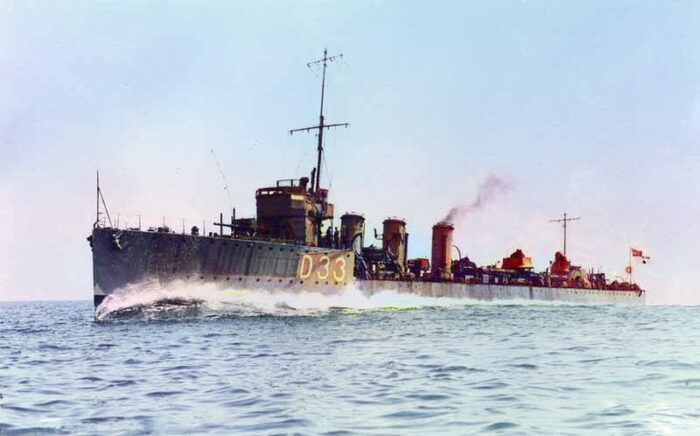
HMS Murray on sea trials (IWM)
The original “M class” were based on the L (Laforey) class destroyer, but much faster (6 knots more) at 34 knots. The speed was upon insistence of 1st Lord of the Admiralty Sir Winston Churchill. The class comprised six “admiralty designs” from three yards, two 4-funneled H.Leslie “specials”, two Thornycroft “specials “and three Yarrow “specials”, 2-funelled, when the norm was three funnels. They all thus diverged in minor details. Three more were cancelled. In wartime, they were relatively lucky, no loss, all survived until sold for BU in 1921 while bringing important services to the Grand Fleet. The class was considered a success and followed by the eighty-nine “repeat M” as well as influencing later designs until the large V-W of 1918.
Development: Emergency War Construction Programme
At the outbreak of war, the Admiralty decided to submit an emergency shipbuilding programme on a specific design, hence the “Admiralty” denomination, largely based on the previous prewar class L. This was, in fact, a “superclass” counting several sub-classes:
-Six prewar “M” ships (which were lighter at 1,010 tons and smaller) built at Palmers, Swan Hunter and John Brown;
-Sixteen “M” ordered in September 1914 (John Brown, Thornycroft, White, Fairfield, Swan Hunter)
-Nine other in November (some with “N” names) (same)
-Twenty-two late November (“N” and “O” names) (same)
-Sixteen February 1915 (“N”, “O” an “P” names) (same, but they had raking stems)
-Sixteen in May 1915 (“M” and “P” names) (same, but raking stems)
Design of the M class
They were all largely based on preceding L class, all ships had three identical narrow circular funnels, a raised forecastle, three QF 4 in (102 mm) Mark IV guns, on mounting P Mk.IX, one forward, two aft, with the “Y” gun raised on a superstructure, and two twin banks of 21 in (533 mm) torpedo tubes. Anti-aircraft artillery was also present with two individual QF 2-pounder Bofors “pom-pom” Mk.II. Displacement was about 1000 tonnes (994 light, 1010 standard, 1059 fully loaded). These were propelled by three shafts in direct drive with steam turbines, 25,000 shp (18,642 kW) for a top speed of 34 knots (39.1 mph; 63.0 km/h). These were sturdy ships fit for the North Atlantic and North Sea, with a sufficient range due to their 237–298 tons fuel oil carried. The pre-war sub-group only had cruising turbines, the idea was dropped for mass-production. Another difference was the second 4 inch-gun was mounted on a bandstand.
Hull & General Layout
Powerplant
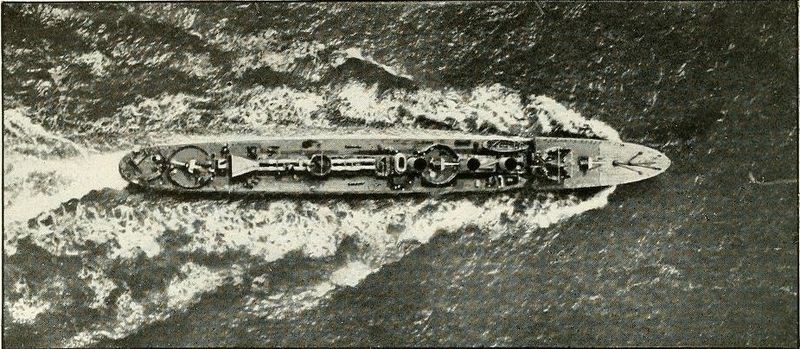
Aerial view of a M class in 1918
Armament
4-in Mark VIII/40 (101.6 mm)
These were designed in 1908 and entered service on the HMS Swift, Tribals, Beagle, Acorns and Acherons.
⚙ specifications 4-in Mark VIII |
|
| Weight | 2,912 pounds (1,320 kg) |
| Barrel lenght | 159.2 inches (4.044 m) bore 40 calibres |
| Elevation/Traverse | -10° to +20°, 360 |
| Loading system | Welin single-motion screw breech |
| Muzzle velocity | 2,287 feet per second (697 m/s) |
| Range | 10,210 yards (9,340 m) |
| Crew | 8 |
| Round | 31 pds (14.06 kg) Common lyddite |
| Rate of Fire | 6-8 RPM |
QF 12-Pdr 12 cwt
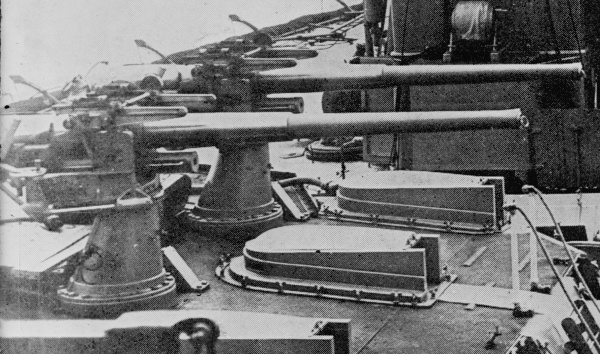
The QF 12 pounder 18 cwt gun (Quick-Firing) was a 3-inch high-velocity naval gun intended at first for battleships to deal with torpedo boats. 18 cwt referred 112 lbx2,016 lb or 914 kg unlike the strick “12 pounder” with was actually 12.5 lb or 5.7 kg. They ended on a lot of capital ships.
They had P. V mountings with 100 rounds per gun just as the “Tribal” group., capable of +20° and -10° which was important to deal with submarines close.
Sights were cam-worked with range dials for 2150 fps also used as .303-in aiming rifles elevating the same, with graduations ending at 19.25° or 8100 yards full charge. Deflection gearing was constant at 43.76, 1 knot= 3.76 arc minutes, for a muzzle velocity of 2197 fps at 2000 yards.
The drift was corrected by inclining the sight 2 degrees with left sights 10.25 inches above the bore, 10 inches left. But the sight could be also used as free sight, with an open sights for the layer. There was no temperature corrector however.
In late 1913, these gun mountings started to receive percussion firing gears.
⚙ specifications 12-pdr, 12 Cwt |
|
| Weight | 2,016 lb (914 kg) |
| Barrel lenght | 150-inch (3.81 m) 50 calibres |
| Elevation/Traverse | |
| Loading system | |
| Muzzle velocity | 2,600 ft/s (790 m/s) |
| Range | 9,300 yards @ +20° (8,500 m @ +20°) |
| Crew | 5 |
| Round | Separate QF 12.5 lb (5.66 kg) |
| Rate of Fire | 20 rd/min |
21-in Torpedoes
The new RGF Mk II 21-in torpedo with the Hardcastle heater was adopted in this class. It ran at 5Okts (93 km/h; 58 mph) over 1000yds (910 m) or 12,000yds (11,000 m) at 30kts (56 km/h; 35 mph). Two spare torpedoes were carried. Instead of the “Short” Mark I they carried the “Long” Mark I at 23 ft 1.25 in (7.042 m) thanks to their longer tubes and then the Mark II. The Mark I long explosive charge was 200 lb (91 kg) of gun cotton, increased later to 225 lb (102 kg). The spare torpedoes were stowed either side at the foot of the searchlight platform on deck.
But the bead and breakfast of these ships in WWI was their Mark II introduced in 1914:
⚙ specs Mark II TORPEDO |
|
| Weight | 1,6t |
| Dimensions | Diameter 534 mm, Length 681 cm |
| Propulsion | Wet Heater |
| Range/speed setting | 5,500 yards (5,000 m)/30 knots |
| Warhead | 280 lbs. (127 kg) wet gun-cotton |
Depth Charges
In July 1912, HMS Alarm was the first fitted for trials of an explosive sweep mated with electrically-fired charge. In May 1918, Nymphe combined a sweep gear with two depth charge throwers (Y-guns) and four stern chutes, 12 charges. The new standard in 1918 was two depth charge throwers (DCT or Y guns) eight spares, one ‘runner” with 23 charges. They no longer carried Paravanes to compensate for this 7.5 tons increase, some even had to land their aft 4-in gun.
Fire Control
By 1915 fixed voice pipes were added between decks ending with flexible mouths, one for gunnery, one for torpedoes and linking the bridge with the guns, torpedo tubes and searchlights stations. There was a third fully flexible voicepipe from bridge to the forward gun to pass informations.
The Acorns had a one meter base rangefinder, supplied to all destroyers of the “Tribal” class and delivered up to the “L” class of 1916.
In 1920 destroyers from the Acorn to Laforey classes had Wise Pressure Telegraphy Systems in place, in support of the fire control.
The main sighting position located high up in the centre of the bridge used a single set of firing pushes/keys and keys for operating a buzzer lighting at the forward torpedo mount and rattler at the aft mount. Data instruments were electrical with a Mark I deflection transmitter from the control post, separate order transmitters and keys (forward tube, aft tube) with each mount had having a combined receiver for these electric signals.

Author’s 1/750 Profile of a M-class torpedo-boat destroyer.
M-class (1914 specifications) |
|
| Displacement | 994t, 1042t FL |
| Dimensions | 82 x 8,4 x 3,2m (269 x 27 x 10ft) |
| Propulsion | 3 shafts, steam turbines, 25,000 shp (18,642 kW) |
| Speed | 34 knots (39.1 mph; 63 km/h) |
| Armament | 3x 4-in (102 mm) Mark-IV QF, 2×2 pdr (40 mm) AA, 2×2 21-in (533mm) TTs. |
| Crew | 80 |
About the “Greeks and Turks”
A simplified way to tacked eight destroyers coming from requisitioned orders, albeit some had relatively foggy origins. What is important was their similarities with the M class.
As for the next “repeat M” they will be there only as an introduction before they are treated as standalones in the future.
About the “Repeat M”
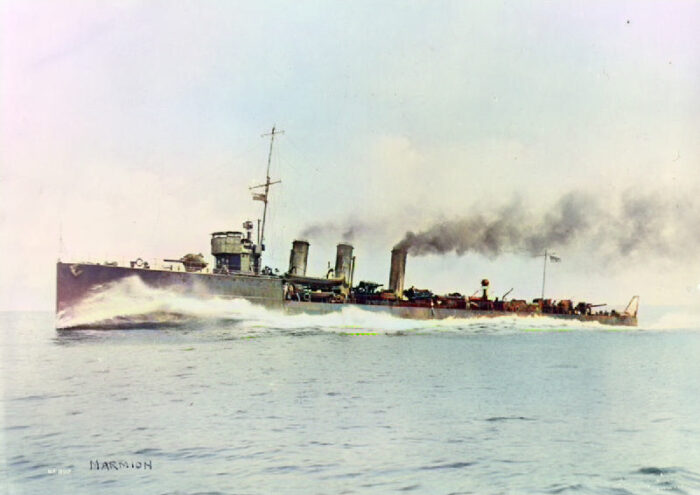
HMS Marmion on sea trials in 1915 (IWM)
.jpg)
HMS Marmion in 1915, “repeat M”, here, the original.
.jpg)
HMS Minon in 1915, “repeat M”
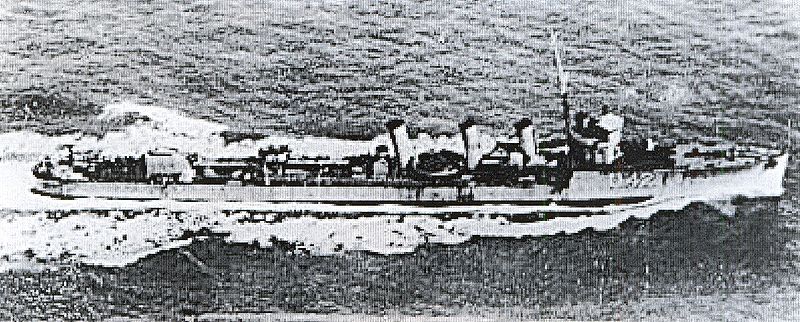
HMS Pasley, of the later “repeat M”
.jpg)
HMS Paladin in 1916, of the later “repeat M”
General Evaluation
All these ships were quite active during the war. HMS Marmion (1917), HMS Negro (1916), HMS Nessus (1918), HMS Narborough (1918), Narwhal (1916) were lost by collision with other ships or reefs, HMS Mary Rose by cruiser SMS Brummer and SMS Bremse off the Norwegian coast, the HMS Partridge by German destroyers in December 1917, the HMS North Star at Zeebrugge in 1918, HMS Pheasant (mine, 1917 off the Orkney Islands) and more famously the HMS Nestor and Nomad were sunk at the battle of Jutland. The remainder sold for scrap in 1921. During the war, Partridge, Norman, Maenad, Ophelia and Observer all received equipment to operate a kite balloon.
Active service
Note: single star: H. Leslie special. 2 stars: Thornycroft special. 3 stars Yarrow special.
 HMS Matchless
HMS Matchless
 HMS Murray
HMS Murray
 HMS Myngs
HMS Myngs
 HMS Milne
HMS Milne
 HMS Moorsom
HMS Moorsom
 HMS Morris
HMS Morris
 HMS Mansfield*
HMS Mansfield*
 HMS Mento*
HMS Mento*
 HMS Mastiff**
HMS Mastiff**
 HMS Meteor**
HMS Meteor**
 HMS Miranda***
HMS Miranda***
 HMS Minos***
HMS Minos***
 HMS Manly***
HMS Manly***
Sources
Books
Conway’s all the world fighting ships 1921-1947.
Links
M-Class destroyers on wikipedia
ww1 British Destroyers on navypedia
https://www.tynebuiltships.co.uk/M-Ships/matchless1914.html
https://www.wartimememoriesproject.com/greatwar/ships/view.php?pid=1892

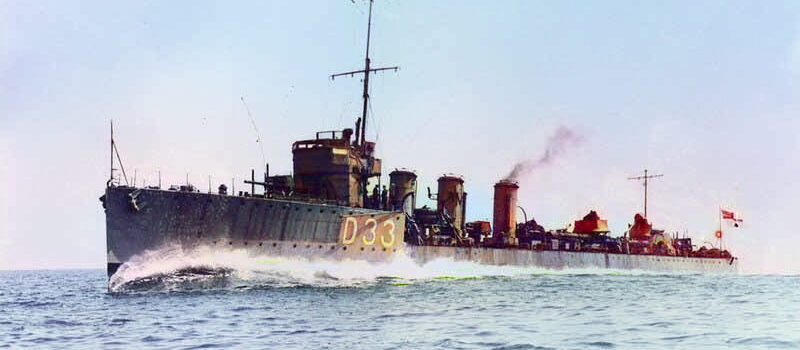
.jpg)
 Latest Facebook Entry -
Latest Facebook Entry -  X(Tweeter) Naval Encyclopedia's deck archive
X(Tweeter) Naval Encyclopedia's deck archive Instagram (@navalencyc)
Instagram (@navalencyc)

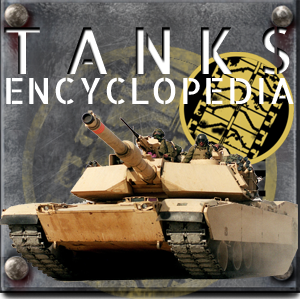
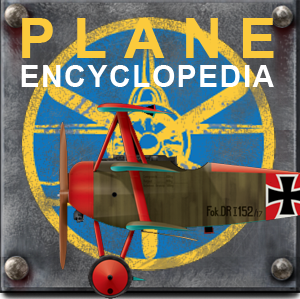
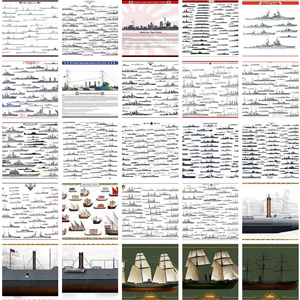
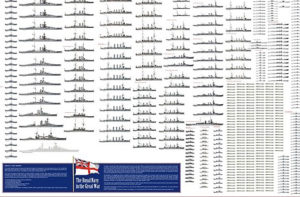
 French Navy
French Navy Royal Navy
Royal Navy Russian Navy
Russian Navy Armada Espanola
Armada Espanola Austrian Navy
Austrian Navy K.u.K. Kriegsmarine
K.u.K. Kriegsmarine Dansk Marine
Dansk Marine Nautiko Hellenon
Nautiko Hellenon Koninklije Marine 1870
Koninklije Marine 1870 Marinha do Brasil
Marinha do Brasil Osmanlı Donanması
Osmanlı Donanması Marina Do Peru
Marina Do Peru Marinha do Portugal
Marinha do Portugal Regia Marina 1870
Regia Marina 1870 Nihhon Kaigun 1870
Nihhon Kaigun 1870 Preußische Marine 1870
Preußische Marine 1870 Russkiy Flot 1870
Russkiy Flot 1870 Svenska marinen
Svenska marinen Søværnet
Søværnet Union Navy
Union Navy Confederate Navy
Confederate Navy Armada de Argentina
Armada de Argentina Imperial Chinese Navy
Imperial Chinese Navy Marinha do Portugal
Marinha do Portugal Mexico
Mexico Kaiserliche Marine
Kaiserliche Marine 1898 US Navy
1898 US Navy Sovietskiy Flot
Sovietskiy Flot Royal Canadian Navy
Royal Canadian Navy Royal Australian Navy
Royal Australian Navy RNZN Fleet
RNZN Fleet Chinese Navy 1937
Chinese Navy 1937 Kriegsmarine
Kriegsmarine Chilean Navy
Chilean Navy Danish Navy
Danish Navy Finnish Navy
Finnish Navy Hellenic Navy
Hellenic Navy Polish Navy
Polish Navy Romanian Navy
Romanian Navy Turkish Navy
Turkish Navy Royal Yugoslav Navy
Royal Yugoslav Navy Royal Thai Navy
Royal Thai Navy Minor Navies
Minor Navies Albania
Albania Austria
Austria Belgium
Belgium Columbia
Columbia Costa Rica
Costa Rica Cuba
Cuba Czechoslovakia
Czechoslovakia Dominican Republic
Dominican Republic Haiti
Haiti Hungary
Hungary Honduras
Honduras Estonia
Estonia Iceland
Iceland Eire
Eire Equador
Equador Iran
Iran Iraq
Iraq Latvia
Latvia Liberia
Liberia Lithuania
Lithuania Mandchukuo
Mandchukuo Morocco
Morocco Nicaragua
Nicaragua Persia
Persia San Salvador
San Salvador Sarawak
Sarawak Uruguay
Uruguay Venezuela
Venezuela Zanzibar
Zanzibar Warsaw Pact Navies
Warsaw Pact Navies Bulgaria
Bulgaria Hungary
Hungary

 Bundesmarine
Bundesmarine Dutch Navy
Dutch Navy Hellenic Navy
Hellenic Navy Marina Militare
Marina Militare Yugoslav Navy
Yugoslav Navy Chinese Navy
Chinese Navy Indian Navy
Indian Navy Indonesian Navy
Indonesian Navy JMSDF
JMSDF North Korean Navy
North Korean Navy Pakistani Navy
Pakistani Navy Philippines Navy
Philippines Navy ROKN
ROKN Rep. of Singapore Navy
Rep. of Singapore Navy Taiwanese Navy
Taiwanese Navy IDF Navy
IDF Navy Saudi Navy
Saudi Navy Royal New Zealand Navy
Royal New Zealand Navy Egyptian Navy
Egyptian Navy South African Navy
South African Navy






























 Ukrainian Navy
Ukrainian Navy dbodesign
dbodesign